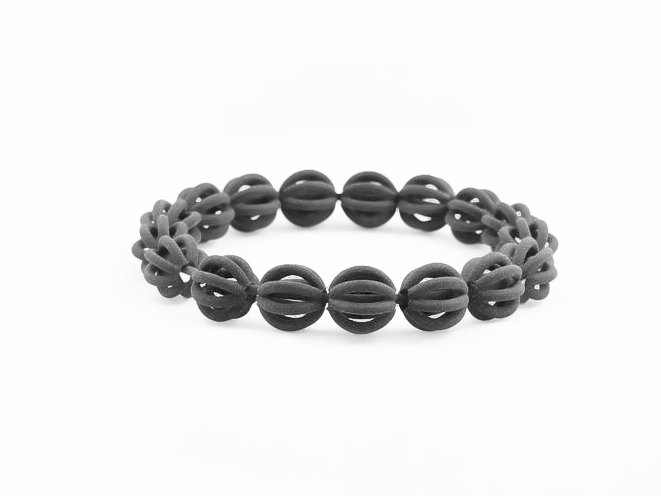Where Style Meets Innovation With Intricate Plastic 3D Printed Jewelry Transforming Fashion Design
Introduction
Plastic 3D printing is redefining jewelry design by enabling the creation of intricate, lightweight, and highly customized fashion pieces. Through advanced plastic 3D printing technologies like Stereolithography (SLA), Multi Jet Fusion (MJF), and Fused Deposition Modeling (FDM), fashionable plastic materials such as Resins, Nylon (PA), and PETG empower designers to bring visionary concepts to life without the limitations of traditional manufacturing.
Unlike conventional jewelry crafting, plastic 3D printing for fashion accessories allows for faster prototyping, complex structural freedom, lightweight construction, and cost-effective production of bold, innovative designs.
Applicable Material Matrix
Material | Surface Finish Quality | Tensile Strength (MPa) | Flexibility | Weight | Jewelry Suitability |
|---|---|---|---|---|---|
Excellent | 50–70 | Moderate | Lightweight | Fine intricate jewelry | |
Very Good | 50–80 | High | Ultra-Lightweight | Flexible statement pieces | |
Good | 45–50 | Moderate | Lightweight | Durable fashion accessories | |
Excellent | 10–15 | Very High | Lightweight | Soft wearable pieces | |
Good | 50–70 | Low | Lightweight | Prototyping fashion jewelry |
Material Selection Guide
High-Detail Resin (SLA): Best for capturing ultra-fine details and smooth surfaces, ideal for delicate earrings, ornate pendants, and precision filigree designs.
Nylon (PA): Extremely durable and flexible, Nylon is perfect for producing wearable, lightweight statement pieces like cuffs, collars, and layered necklaces.
PETG: Combining strength and durability with good transparency, PETG is excellent for creating bold, translucent jewelry designs and wearable sculptures.
Flexible Resin: Offers high flexibility and softness, ideal for creating comfortable, wearable rings, flexible bracelets, or molded fashion accessories.
Standard PLA: Cost-effective and easy to print, PLA is often used for fast prototyping of fashion jewelry concepts before final production.
Process Performance Matrix
Attribute | Plastic 3D Printing Performance |
|---|---|
Dimensional Accuracy | ±0.05 mm |
Surface Roughness (As-Printed) | Ra 5–10 μm |
Layer Thickness | 50–100 μm |
Minimum Feature Size | 0.2–0.4 mm |
Process Selection Guide
Intricate Design Freedom: 3D printing allows the creation of highly detailed organic forms, lattice structures, and complex interlocking elements impossible with traditional techniques.
Lightweight Structures: Optimized printing processes enable ultra-lightweight yet durable designs perfect for large statement jewelry without sacrificing wearer comfort.
Material Versatility: Many plastics and resins offer customizable finishes — matte, glossy, transparent, or dyed to match brand aesthetics.
Rapid Iteration and Customization: Designers can quickly prototype multiple variants of collections, adjusting shapes, sizes, and textures without the cost of retooling.
Case In-Depth Analysis: SLA 3D Printed Statement Earrings for Fashion Collection Launch
A fashion brand needed a collection of lightweight yet bold statement earrings for a runway show. We fabricated ultra-fine, intricate pieces using our plastic 3D printing service with high-detail SLA resin, achieving tolerances within ±0.05 mm. Each earring weighed less than 5 grams while maintaining excellent structural integrity. Post-processing included surface finishing and coloring to achieve a glossy, high-fashion look aligned with the brand’s identity. The project accelerated the collection launch by cutting prototyping time by 40% compared to traditional handcrafting.
Industry Applications
Fashion and Jewelry Design
Statement necklaces, bracelets, rings, and earrings.
Intricate wearable sculptures for fashion shows.
Custom, limited-edition jewelry series.
Consumer Customization
Personalized jewelry collections through online customization platforms.
Made-to-order wedding accessories and keepsakes.
Art and Exhibition Pieces
Wearable art installations and gallery exhibits.
Museum replicas of historical jewelry.
Mainstream 3D Printing Technology Types for Plastic Jewelry Components
Stereolithography (SLA): Best for high-detail, smooth-surface artistic jewelry and wearable designs.
Multi Jet Fusion (MJF): Ideal for strong, flexible fashion pieces and customizable wearable designs.
Fused Deposition Modeling (FDM): Suitable for prototyping jewelry concepts and producing affordable production models.
FAQs
What plastic materials are best suited for 3D printed jewelry designs?
How does plastic 3D printing enable more intricate and lightweight jewelry creations?
What post-processing techniques are used to enhance the appearance of 3D printed jewelry?
Can 3D printed plastic jewelry pieces match traditional craftsmanship in quality?
How does 3D printing speed up the design and production process for custom fashion jewelry?

